Taco Bell Eat Your Words
Off to a Good Start (SILVER)
Best Matching of Message to Medium(s) (SILVER)
Client Credits: Yum! Restaurants International (Canada)
Veronica Castillo – Marketing Manager
Adrianne Chow – Marketing Director
Agency Credits: Grip Limited
Julia Morra – Art Director
Trevor Gourley – Copywriter
Ben Weinberg – Associate Partner, Creative
Pat Andrews – Associate Partner, Creative
Duane Vandermuelen – Editor
Liz Crofton – Agency Producer
Patrick Tomasso – Associate Director, Creative Content
Michael Leutner – Manager, Business
Section I — BASIC INFORMATION
| Business Results Period (Consecutive Months): | June 2013 – May 2014 |
| Start of Advertising/Communication Effort: | August 2013 |
| Base Period as a Benchmark: | Calendar 2012 |
Section II — SITUATION ANALYSIS
a) Overall Assessment
In 2012 Taco Bell launched a new product in the United States that revolutionized the world of Quick Service Restaurants: the Doritos Locos Taco (DLT). A movement was born and the brand in the US enjoyed a surge of business from continuously engaged consumers that moved the needle on top of mind awareness and purchase intent.
Meanwhile, north of the border, the appetite for tacos was underwhelming. Canadians’ perception of the brand was drastically different, reflected in negative sales data year-over-year (see EXHIBIT A). With ongoing store closures [Footnote 1] limiting distribution points, outdated store assets, low brand awareness (see EXHIBIT B), and a confused brand identity, Taco Bell was the perennial underdog in a very loud and competitive QSR playing field.
Exhibit A:
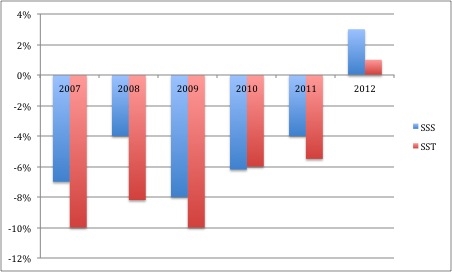
Exhibit B:
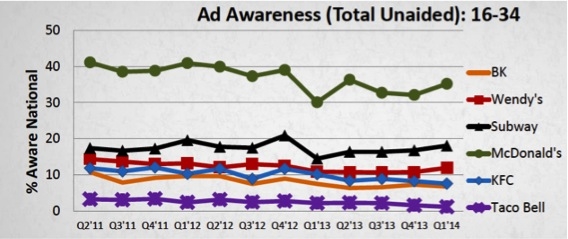
After the DLT launch in the US, Canadians were vocally frustrated – they had missed the invite to the DLT party, and weren’t shy about letting Taco Bell Canada know how they felt on Taco Bell’s Twitter and Facebook pages.
Taco Bell Canada would need to find a way to rise above flat marketing budgets and the lowest share of voice (see EXHIBIT C) amongst competitors in order to break through the clutter, win back the disenfranchised and forge a meaningful connection with them.
Exhibit C:
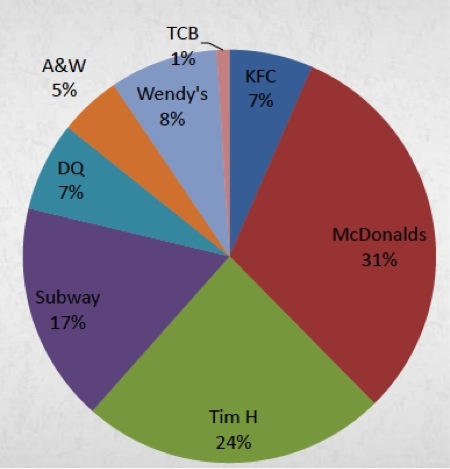
b) Resulting Business Objectives
Taco Bell decided to respond to its highly engaged critics by bringing one million DLTs to Canada for a limited time only. To justify the operational investment required for the innovation, the following business objectives were set:
- Increase same Store Sales Growth by 7%
- Increase Sales Mix by 6-10%
- Drive trial amongst light/medium users
- Acquire fans in social communities
c) Annual Media Budget
$1 – $2 million
d) Geographic Area
Nationally across Canada (excluding Quebec)
[Footnote 1] 29 independent stores of 151 shared KFC-Taco Bell restaurants; 680 KFC Stores, 1400 McDonalds stores, 3000 Tim Hortons stores
Section III — STRATEGIC THINKING
a) Analysis and Insight
Despite having a low share of voice and small marketing budget, Taco Bell has consistently maintained great dialogue through a strong social community that has energized its fans. By reviewing sentiment as part of a monthly social analytics plan, the DLT aggressors were noticed. They were funny, honest and straight up, just like the Taco Bell tone of voice. They inspired us.
When it was confirmed that DLT would be coming to Canada, we knew that the business and brand environments weren’t comparable with the US. We knew from listening to our fans that they were very different than the US consumer. Their level of product knowledge, their passion and their frustration, required a uniquely Canadian campaign that re-evaluated the goals of the brief (awareness and trial) and went straight for the heart—loyalty.
So we turned the brief on its head. With a consumer who, without our help, knew everything about the product and begged for it in social media, we knew we needed to take this opportunity to restore our national brand reputation and even use the DLT as the catalyst to restore the master brand identity.
We were inspired by a few powerful observations:
- Small scale social tests with fans that proved they craved interaction with our brand, and when provided and empowered, came back to re-engage again and again; and
- DLT test-market research out of the US proved the product generated significant word-of-mouth in the target group.
From these findings we learned that if our fans feel like we’ve listened, their engagement becomes contagious. Distilled into a single powerful insight: Young Adults expect to be heard.
b) Communication Strategy
Singling out a smaller community of highly engaged Young Adults with strong opinions was both the challenge and the opportunity. Looking to them, we made a risky move that put Taco Bell on the line – we harnessed their frustration, their anger, their humour and their passion in a campaign that would launch the DLT in Canada: Feed the fans.
With the product launch, we would feed the fans what they’d been feeding back to us for over a year: “I want DLT, and why can’t I have it yet, Taco Bell Canada?”. It became more than a campaign platform – it became the rallying cry for how we brought the product to market. The communication strategy was built on a “fans first” model that put our most vocal consumers at its core, where they rightfully belonged.
The success of the brand in social space was less about micromanaging the organic activity, and more about creating valuable and unique experiences for the fans. It started with an online teaser campaign, followed by a totally unique product launch where we invited our loudest critics to a mind-blowing surprise event that would, in their own words, change their lives forever – and where they could be the first in Canada to get their hands on DLT. From beginning to end, the launch strategy hinged on creating unforgettable experiences that were exclusive to our brand enthusiasts. And from there, it paid off.
Section IV — KEY EXECUTIONAL ELEMENTS
a)Media Used
Feed the Fans was supported through a variety of different mediums, including:
- Twitter
- Fan outreach
- Promoted tweets
- Facebook
- Fan outreach
- Promoted posts
- YouTube
- Online video
- Microsite
- Buzzfeed
- Sponsored articles and ad placement
- Snapchat
- National TV (excluding Quebec)
- Pre-roll
- Page takeover
b)Creative Discussion
To launch the campaign, we invited four of our loudest critics through Twitter to join us at a Taco Bell location in Toronto with a compelling call to action: Eat Your Words. They had no idea why they were coming, or what the visit was about. Cameras were set up to capture the experience as a Taco Bell employee surprised them with a Nacho Cheese DLT. But not just any DLT—they got a DLT featuring their own taco-demanding tweets and posts, laser-etched into the Doritos taco shell (see EXHIBIT D). We watched on as they literally ate their words.
Exhibit D:

Prior to the product launch through the online video content, the brand tweeted a series of ambiguous messages that teased a “special announcement”. Images associated with the tweets were treated with a consistently mysterious look and feel, so each piece of communication built the drama with our followers. Fans were extremely intrigued, and the guessing game began.
Four days prior to the product launch and online video campaign, the “special announcement” messages were also posted on Facebook(see EXHIBIT E). But this time, an invite was extended: anyone that followed Taco Bell on Facebook was invited to a mysterious exclusive event at a Taco Bell location in Toronto for “something special”. It was this event that allowed our most loyal ambassadors to debut the DLT exclusively before the public, bringing to life the campaign platform of Feed the Fans and launching the fan engagement and acquisition strategy (see EXHIBIT F).
Exhibit E:

Exhibit F:
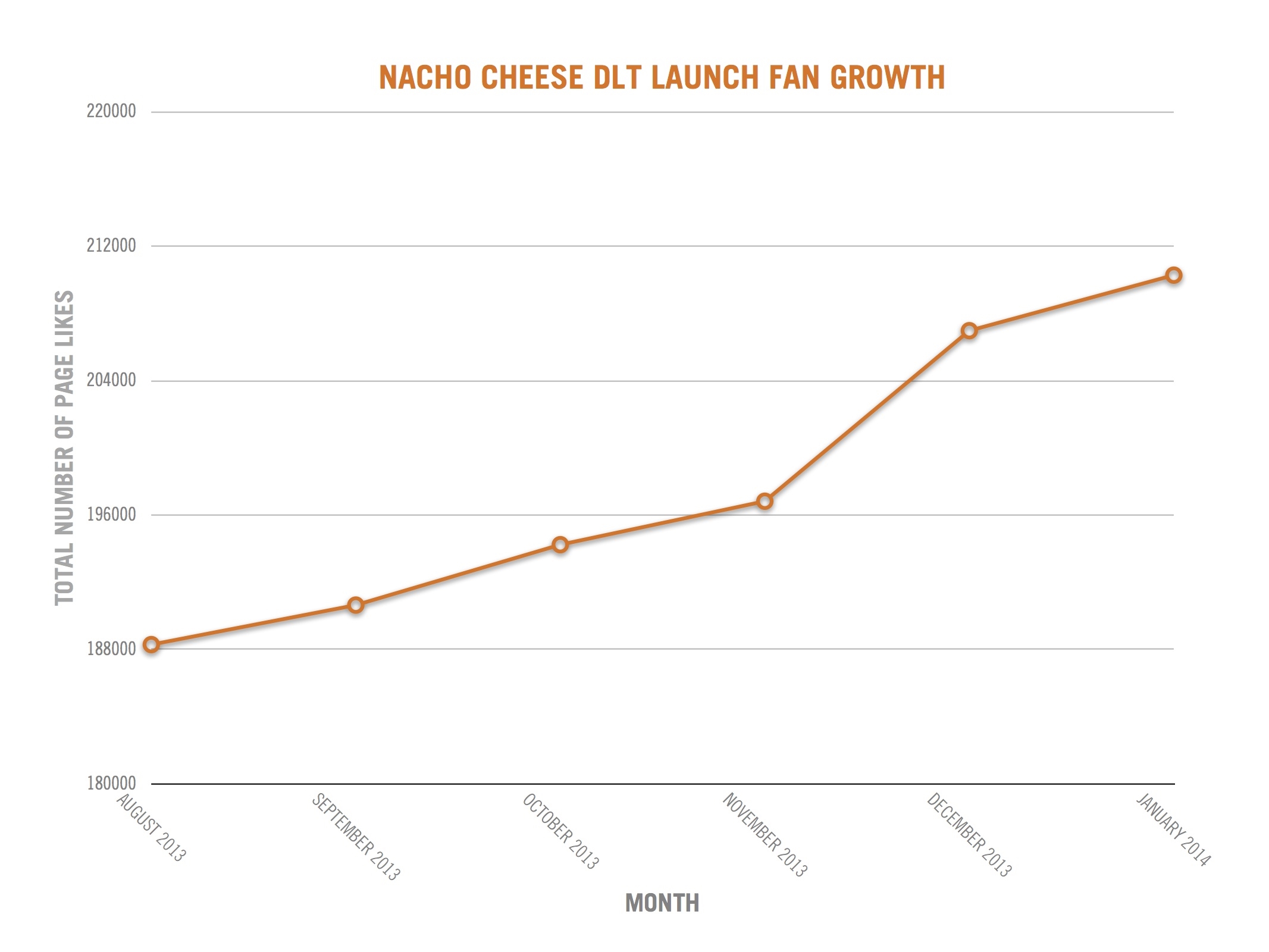
YouTube
On the day the product arrived in restaurants, the Eat Your Words online video content was launched on YouTube and pushed to all Taco Bell social communities to drive reach and engagement. The announcement was made: 1,000,000 DLTs were available in Canada and would be going fast.
Microsite
With the tacos in limited supply, the brand launched a microsite with a live ticker to count down the remaining DLTs in the country (see EXHIBIT G). The taco countdown drove urgency to purchase, and showcased a gallery of user-generated content. Tweets, Instagram photos and Vine videos of fans enjoying the DLT were aggregated under a common hashtag: #DLTCANADA so fans could continue to be an integral part of the action.
Exhibit G:

Snapchat
Stills from the Eat Your Words video shoot were used as Snapchats and sent out to our community of followers so they could literally watch as the DLT disappeared on their screen—adding more urgency to the 1 million taco countdown.
Buzzfeed
The fact that DLT itself drove valuable WOM, coupled with laser-etched Doritos shells, made quirky news site Buzzfeed a relevant environment to engage (see EXHIBIT H). Taco Bell sponsored share-worthy articles that drew parallels to the unique product itself (“Food Mashups You Wish You Thought Of First”).
Exhibit H:
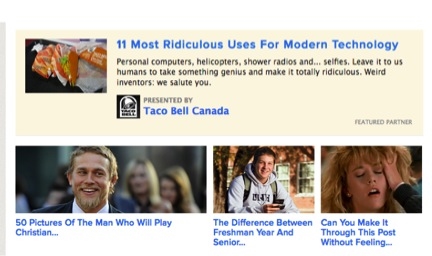
TV
For production efficiencies, an adaptation of a DLT spot from the US was used to generate mass awareness, while a 15 second edit of the “Eat Your Words” video drove viewers to the longer format YouTube version. The spot was tagged with the promotional hashtag #DLTCanada to encourage viewers to join the ongoing conversation online, which ultimately converted them to members of the DLT community through the delivery of rich, original content that left them wanting more.
After several months of extremely successful DLT sales and conversation in Canada, Taco Bell decided that the product would become a permanent menu item, launching to the masses as part of the core menu mix in January of 2014. The powerful impact the DLT had made on Taco Bell loyalists deserved to be highlighted in a disruptive stunt. True to the fans-first model, we began by teasing video content about another “special announcement” to our Facebook and Twitter communities. The chatter erupted yet again. Through the hashtag “#DLT4LIFE”, we asked our fans how far they would go to make DLTs a permanent menu fixture (SEE EXHIBIT I). The response was phenomenal. But the winning fan took his DLT passion to another level – he declared he was willing to get a taco tattoo in exchange for DLTs for life (SEE EXHIBIT J). And he actually followed through. His DLT tattoo experience was filmed and posted on Twitter, Facebook, Instagram and YouTube to announce that DLT was here to stay. Once again, our fans’ passion for the DLT figured prominently in the campaign story, and the impact was big. The stunt campaign successfully rejuvenated the DLT story that had been on center stage for months. Sales began to grow as the campaign sustained top of mind awareness of the product and even further strengthened the loyalty for what had become a Canadian favourite.
Exhibit I:
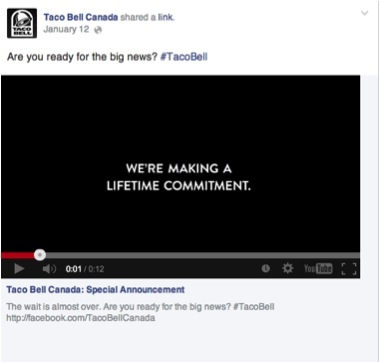
Exhibit J:
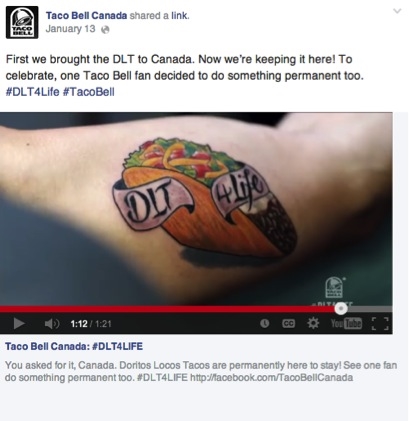
c)Media Discussion
With a lean media budget, the immediate priority was to support the unconventional, loyalty-building content in digital so the movement would take a shape of its own. For that reason, dollars were prioritized towards the teaser campaign on Twitter and Facebook.
Once the campaign launched successfully through the priority social channels, the Eat Your Words video content was extended as pre-roll material for mass awareness of the DLT product launch in Canada.
Supporting the continued investment of promoted posts, tweets and pre-roll, was the unique Buzzfeed content that ran alongside contextual ad placement that drove traffic to the campaign microsite.
Adapt TV ran for the duration of the campaign to build and sustain awareness levels of the product’s arrival in Canada. This was supplemented by a 15 second version of the Eat Your Words video.
To support the permanent menu item launch of the DLT in January 2014, the original fan tattoo video content and narrative was pushed through a YouTube buy, promoted on Facebook and Twitter, and accompanied by :15s DLT TV.
Exhibit K:
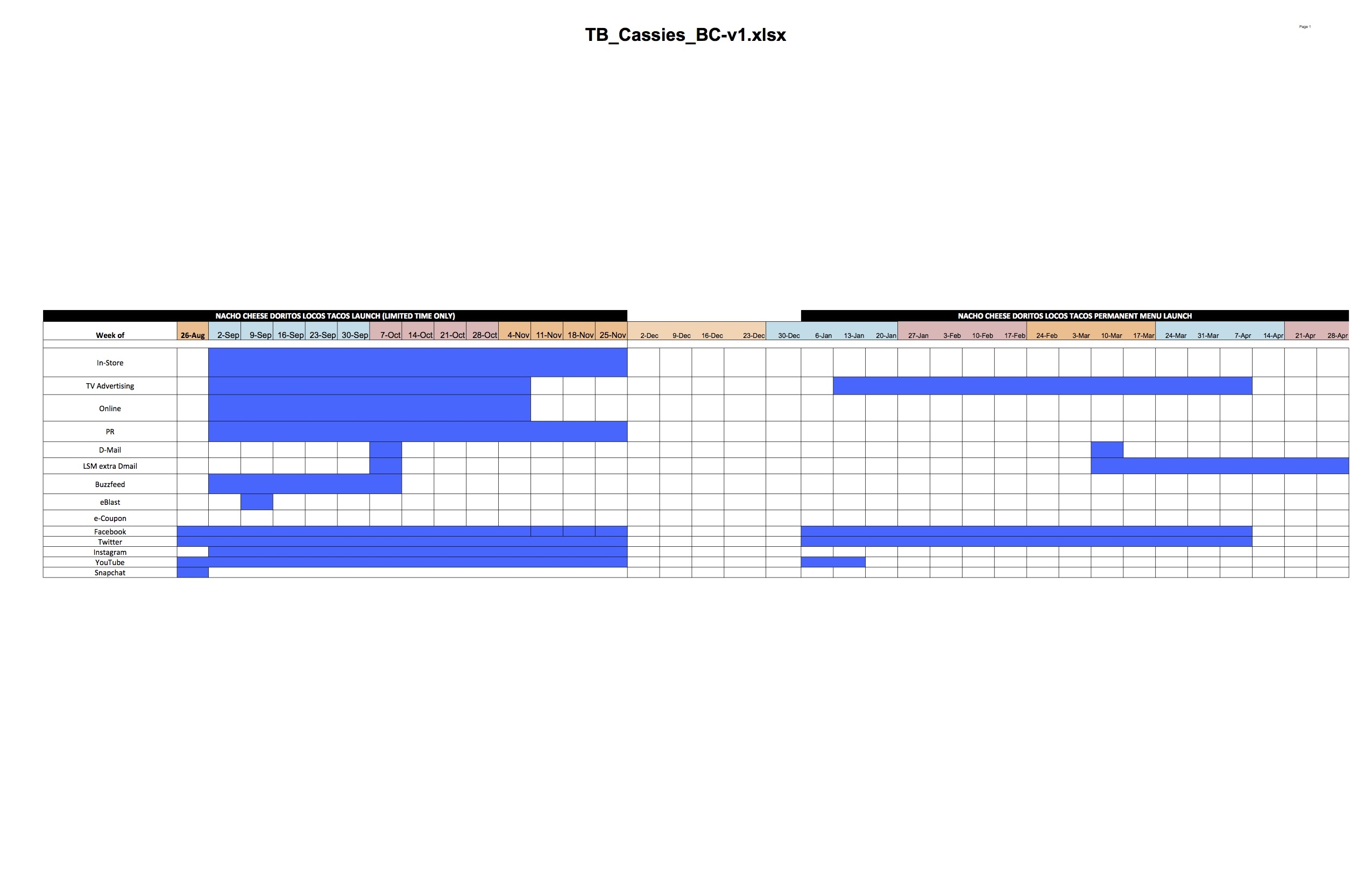
Section V — BUSINESS RESULTS
a) Sales/Share Results
The fans first strategy drove business results higher than Taco Bell could have imagined. With a sustained awareness campaign to support the launch, and strong WOM driven by brand enthusiasts, Canadians could not get enough of the DLT. This passion translated into higher levels of overall preference for the brand, a halo effect that contributed to major increases in overall Same Store Sales Growth. Through strong innovation, Taco Bell Canada underwent a powerful transformation that shifted the brand promise from “food as fuel” to “food as an experience”, a concept that was driven home by strong and meaningful engagement with the fans who valued this experience the most. The product launch itself drove the following business results:
- Sales grew an average of 10% (see EXHIBIT L)
- From 1% sales growth pre-campaign, DLT helped Taco Bell realize a record high 16% sales growth for the year (see EXHIBIT M)
- Average cheque size grew 6%
- DLT Boxed Meal (combo) grew 6.4% over the average of 2%, proving the item to be a strong up-sell tool
- 4.5 MM Twitter impressions
- 21-23% click-through rates on contextual online advertising to campaign microsite
- 33% lift in social engagements through Buzz Feed sponsorship
- 625% lift in DLT mentions in Canada (see Exhibit N)
This consistent double-digit sales growth had not been realized by the brand for as far back as data will take us, despite low awareness scores and the lowest SOV of major competitors. What’s more, the DLT launch and sustain program led the brand in Canada closer to the soul of the American creative platform, Live Mas, which means “creativity with a twist, doing more and giving more with passion”. By connecting with our core brand champions to bring the DLT to market in an unforgettable loyalty campaign, Taco Bell Canada as an organization underwent a step-change transformation that re-focused a confused brand. With a new focus on feeding people’s lives with Mas, consumers have begun to reconsider what it means to enjoy a Taco Bell experience, exhibited through sustained national positive sales growth of +7.7% across 2014 and an increase in overall transaction growth of +2.4%.
Exhibit L:
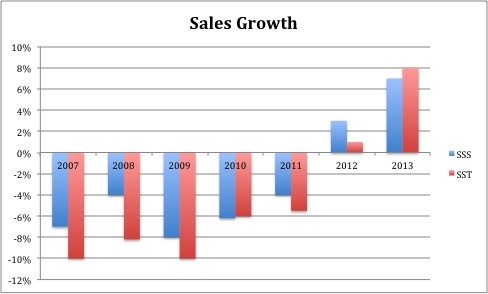
Exhibit M:

Exhibit N:
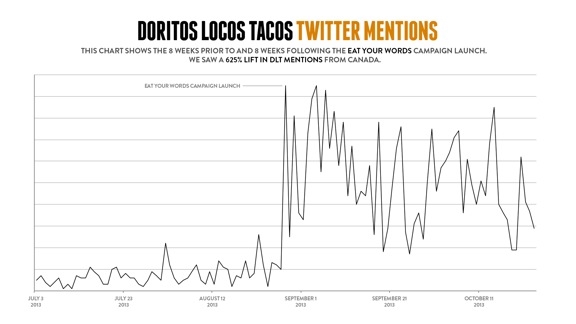
b) Consumption/ Usage Results
c) Other Pertinent Results
d) Return on Investment
Section VI — CAUSE & EFFECT BETWEEN ADVERTISING AND RESULTS
a)General Discussion
As one of only three campaign windows supported by mass advertising for the year and the only window that won budget to create original content, the connection between DLT communications efforts and the resulting lift in sales is evident.
The response to the original Feed the Fans content was huge, with massive engagement that outperformed any Canadian Taco Bell promotion ever. The campaign received attention nationally and internationally, with features in the Huffington Post, Creativity, AdWeek, FastCompany, and Strategy Magazine. Followers on Twitter doubled during the period, and even Canadian celebrities and star hockey players got involved in the conversation, praising the brand. The immediate spike in impressions gained through Twitter, Youtube, Facebook and TV resulted in record-breaking double digit Same Store Sales Growth at the front-end of the promotional period.
Feed the Fans helped Taco Bell Canada sell out of DLT faster than expected, and demand continues to creep up on supply today. With a new outlook on the brand, consumers are rethinking what it means to choose Taco Bell, and are proving that skeptics can be turned into loyalists, with consistent sales growth, steady up-selling to combo meals, and overall increased average check size attributable to the traffic the DLT has driven to stores across the nation.
b)Excluding Other Factors
Spending Levels:
Media budgets remained flat YOY. Production budgets were increased by 50% compared with the same period last year.
Pricing:
Product was sold at a $0.30 price premium over the average beef taco.
A coupon was offered after the campaign was complete, in the December period, for three DLT Supremes for $5.00. This would not affect sales lift over the campaign due to the month it was introduced.
Distribution Changes:
Number of standalone stores in 2013 decreased. Business results could not be attributed to new store openings (see EXHIBIT O).
Exhibit O:

Unusual Promotional Activity:
No unusual promotional activity occurred during the campaign period.
Other Potential Causes:
No other potential causes could have affected business results of the DLT in the campaign period.